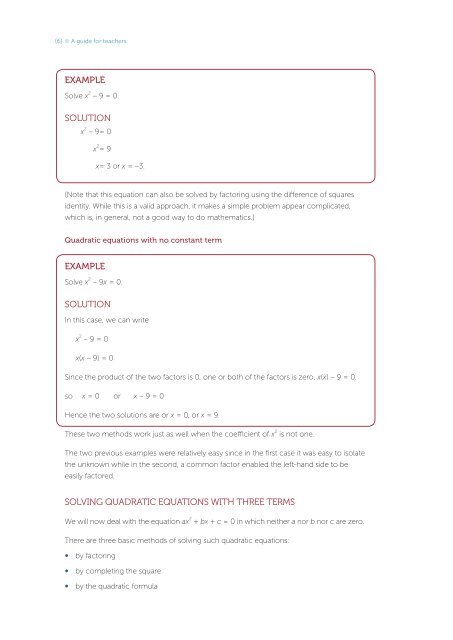quadratic equations - the Australian Mathematical Sciences Institute
quadratic equations - the Australian Mathematical Sciences Institute
quadratic equations - the Australian Mathematical Sciences Institute
- No tags were found...
Create successful ePaper yourself
Turn your PDF publications into a flip-book with our unique Google optimized e-Paper software.
{6} A guide for teachersEXAMPLESolve x 2 – 9 = 0.SOLUTIONx 2 – 9= 0x 2 = 9x= 3 or x = –3.(Note that this equation can also be solved by factoring using <strong>the</strong> difference of squaresidentity. While this is a valid approach, it makes a simple problem appear complicated,which is, in general, not a good way to do ma<strong>the</strong>matics.)Quadratic <strong>equations</strong> with no constant termEXAMPLESolve x 2 – 9x = 0.SOLUTIONIn this case, we can writex 2 – 9 = 0x(x – 9) = 0Since <strong>the</strong> product of <strong>the</strong> two factors is 0, one or both of <strong>the</strong> factors is zero, x(x) – 9 = 0.so x = 0 or x – 9 = 0Hence <strong>the</strong> two solutions are or x = 0, or x = 9.These two methods work just as well when <strong>the</strong> coefficient of x 2 is not one.The two previous examples were relatively easy since in <strong>the</strong> first case it was easy to isolate<strong>the</strong> unknown while in <strong>the</strong> second, a common factor enabled <strong>the</strong> left-hand side to beeasily factored.SOLVING QUADRATIC EQUATIONS WITH THREE TERMSWe will now deal with <strong>the</strong> equation ax 2 + bx + c = 0 in which nei<strong>the</strong>r a nor b nor c are zero.There are three basic methods of solving such <strong>quadratic</strong> <strong>equations</strong>:• by factoring• by completing <strong>the</strong> square• by <strong>the</strong> <strong>quadratic</strong> formula
















